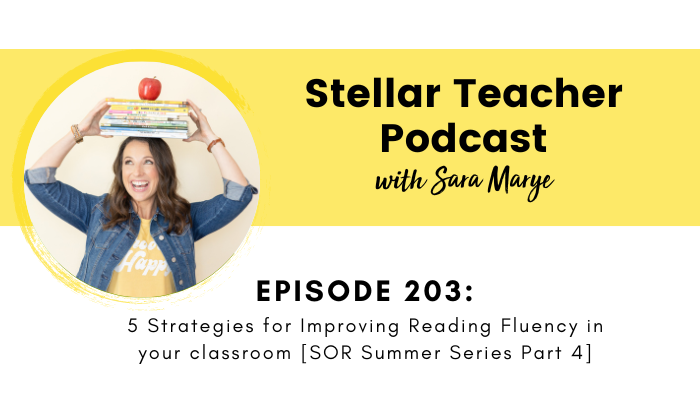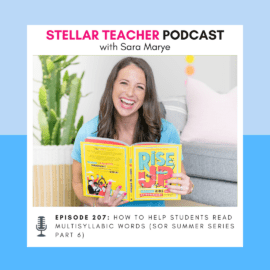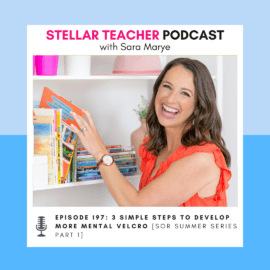
Click play below to hear about 5 strategies you can use in your classroom to improve reading fluency with your students:
One major goal in upper elementary education is to help students become fluent readers. But what does that really mean? Reading fluency goes beyond speed; it encompasses the ability to read words, phrases, and entire sections of text quickly, accurately, and with understanding.
Reading fluency serves as the bridge between decoding and comprehension. Strong fluency skills improve both decoding and comprehension because they introduce a level of automaticity. Fluent readers don’t need to think about how to read or sound out individual words; they read smoothly and quickly, allowing them to focus more mental energy on comprehension, meaning, purpose, and building knowledge.
So, how can we incorporate this knowledge into our classrooms? In this episode, I will share five strategies to build reading fluency with your students. These strategies are practical, fun, and easy to implement. I hope you’ll choose one or two of them to implement in your classroom next year.
In this episode on reading fluency, I share:
- That reading fluency is more than focusing on the speed with which students read.
- What reading fluency is.
- Why focusing on reading fluency with students is important.
- 5 strategies you can use to help build reading fluency with your students.
Resources:
- Get on the waitlist to join The Stellar Literacy Collective
- Join us for our Free Summer Book Study
- Sign up for my Private Podcast: Confident Writer Systems Series
- Sign up for my FREE Revision Made Easy email series
- If you’re enjoying this podcast, please leave a review on Apple Podcasts!
Related episodes:
- 3 Simple Steps to Develop More Mental Velcro (SOR Summer Series Part 1)
- Text Structure: A Roadmap for Reading (SOR Summer Series Part 2)
- What We Need to Understand About Reading Comprehension (And 8 Instructional Strategies)
Connect with me:
- Join my newsletter
- Shop my TPT store here
- Instagram: @thestellarteachercompany
- Facebook: The Stellar Teacher Company
More About Stellar Teacher Podcast:
Welcome to the Stellar Teacher Podcast! We believe teaching literacy is a skill. It takes a lot of time, practice, and effort to be good at it. This podcast will show you how to level up your literacy instruction and make a massive impact on your students, all while having a little fun!
Your host, Sara Marye, is a literacy specialist passionate about helping elementary teachers around the world pass on their love of reading to their students. She has over a decade of experience working as a classroom teacher and school administrator. Sara has made it her mission to create high-quality, no-fluff resources and lesson ideas that are both meaningful and engaging for young readers.
Each week, Sara and her guests will share their knowledge, tips, and tricks so that you can feel confident in your ability to transform your students into life-long readers.
Tune in on your favorite podcast platform: Apple, Google, Amazon, Spotify, Castbox, and more! If you’re loving this podcast, please rate, review, and follow!
Podcast (stellar-teacher-podcast): Play in new window | Download
You’re listening to episode number 203 of the Stellar Teacher Podcast.
Welcome back to another episode of our Stellar Teacher Science of Reading Summer Series. Every Thursday during the month of June and the first part of July, I’m going to be sharing a bonus episode, where I’m going to give you some really practical strategies and action steps that you can take to ensure that your literacy instruction is aligned to the science of reading this next year. Now, before I talk about today’s specific focus, which has to do with fluency, I always like to start off with an explanation of what the science of reading is, and really why it’s important.
And this summer I’ve been talking about and breaking down the simple view of reading, to really give you a foundational understanding of what the science of reading is. So I want you to imagine reading comprehension, which is the goal for all of our students, is the result of a multiplication formula. And that formula is word recognition, multiplied by language comprehension, equals reading comprehension. And here’s how the simple view of reading works. word recognition involves the ability to recognize and decode words on a page, where language comprehension is all about understanding and making meaning from the words and texts, whether we are reading them or hearing them. And according to this model, both components are essential. And they really function like factors in a multiplication problem. So if you think about it, if either word recognition or language comprehension scores zero, then reading comprehension is also going to be a zero. Because if a student has, let’s say, perfect language comprehension, we’ll say that’s scored as a one, but cannot recognize or decode words scored as a zero, our multiplication formula would be zero times one, resulting in zero, which would be their overall reading comprehension. And then, of course, conversely, if a student can decode every single word, which again, we’d score as a one, but they fail to understand the meaning, which will be scored as a zero, the result is going to be the same, one times zero equals zero, so zero for reading comprehension. And this model really illustrates that effective reading comprehension requires proficiency in both decoding and understanding. Because without both a student’s ability to comprehend a text is significantly compromised. Now, if you look at this model, you’re not necessarily going to see fluency listed under word recognition or language comprehension. But fluency really is important in helping our students become skilled readers.
And one of the things that gets talked about in “Shifting the Balance” by Katie Egan Cunningham, Jan Birkins, and Carrie Yates, is that fluency is the link between decoding and comprehension. Because when students have strong fluency skills, both their decoding and comprehension improve, and that’s because fluency brings in a level of automaticity. When students are fluent, they aren’t having to think about how to read or sound out individual words, they can just read them smoothly and quickly, which means that they’re going to be able to free up a lot more of their mental energy to focus on comprehension and meaning and purpose and building knowledge.
And think about an example of when you first learned something, like when you first learned how to type on a keyboard. If you’re anything like me, when you first started learning how to type, you used just one finger on one hand, and you spent so much time searching for individual letters. But the more automatic your typing became, the less you had to think about it. And the easier it would be for you to type up an essay or search for something on the internet. When I type, I no longer have to look at the keyboard and I can rapidly punch keys with multiple fingers on both hands. And I’m actually pretty good at typing and I rarely make any mistakes. That’s because I have automaticity. But it took me lots and lots and lots of practice to get there. It’s not just something that happened. It was the result of intentional practice. I spent hours practicing on Mavis Beacons Learning to Type computer program. It was a phenomenal way to learn how to type it but it took a lot of hours.
Now in a similar way, we need to give students plenty of opportunities to practice and work on their fluency because fluency is not just something that happens. We need to be intentional about it. Now let’s quickly define what fluency is and then I’m going to share with you some really easy strategies that will help your students improve their fluency. So fluency is the ability to automatically read words, phrases, and entire sections of text quickly, accurately and with understanding. It’s not just about speed, there’s a lot of different aspects that go into fluency.
Fluency is one of the five pillars of reading so we know that it is really important and a big part of becoming a skilled reader. And like I mentioned, it has often been described as the link between decoding and comprehension. And like I said, fluency is necessary if we want our students to become skilled readers. Now teachers often wonder, and ask when should I focus on fluency? And the answer is anytime you want. And I really think it’s important that we move away from trying to teach things in buckets and in isolation. I know so often teachers will say things like, I don’t have enough time in my instructional day to focus on fluency. And I get that if you’re trying to teach fluency as its own separate thing, it might be hard to carve out a fluency block in your already JAM PACKED literacy block. But here’s the great thing about fluency. If you’re reading to your students from a read aloud, or you’re working on them with a text in small group, or if they’re doing any sort of reading for independent practice, you have plenty of time for your students to practice fluency. It just takes some intention. So I’m going to share five strategies that you can incorporate into your literacy block and so many different ways. And all you need to do is be intentional about bringing these into your read aloud, into your small group, or into students independent practice.
The first strategy is repeated reading. And it really is as simple as it sounds. A Repeated Reading is when students reread a text multiple times, specifically with a focus of improving their fluency. They could reread a poem, it could be an excerpt from a longer text or a book that they’re reading, it could be a short fluency paragraph. And students can reread the text with the goal of improving their pace, or maybe they want to improve their expression, or maybe they want to work on their accuracy. Repeated readings are great though, because it’s an opportunity for students to see concrete progress in their fluency. Because most students are going to see growth or progress. From the first time they read a text to the last time they read a text. And repeated readings are something that you can easily incorporate into the independent practice portion of your literacy block. Now here is a pro tip, a little suggestion, use repeated readings as a way to show your students like I said, their progress of fluency throughout the year. So one thing that you can do is at the very beginning of the year, is find a maybe it’s a poem, maybe it’s a short paragraph, just a short text for students to read. And you want it to be something slightly challenging for them, you want it to be a struggle, so that way they have something to work on. And then every other month, or maybe once a quarter, record them reading the same text so that they can visually see their progress. And think about how great it would be to hear them read and struggle through the text or not read very quickly or have good pacing at the start of the year. And then at the end of the year to see themselves reading beautifully with great expression, and great pacing That can be such a motivator for your students. And recordings can also be a really great thing to share with parents during conferences. So repeated readings are a great strategy to focus on fluency.
Another strategy that you can do is choral reading. Now choral reading is when students read a text out loud as a group. You could choral read a text as a whole class. And you could incorporate choral reading into your small group instruction, and have your small group read whatever passage they’re working on out loud. You could even have students practice choral reading in partnerships. And this is something that you can incorporate into your morning meeting and have your class read a daily poem or a short text together. Choral reading is great because it helps students to match their pace and pausing and expression to that of the entire group. Here’s a bonus tip. And hopefully you’ll see this is a sort of a natural and easy thing to do. But you can combine choral reading and repeated reading practice at the same time. So you can choral read the same text every day, as part of like I said, your morning meeting or another part of your literacy block and that’s just gonna be a great way to boost students fluency.
All right, another strategy is Echo reading. And Echo reading is simply when students hear somebody read a portion of a text. And then after hearing that text, they’re going to read it out loud. And this could be you as the teacher reading a sentence first or two sentences, and then having your class read those same sentences after you read them. Or you could have a student who is a really fluent reader, they could be the reading leader. And after they read the first sentence or the first line of a poem, the entire class would read the same thing. And Echo reading works best if the text can be broken up into shorter sections. You wouldn’t want to necessarily echo read an entire paragraph where you read a whole paragraph and then students read the paragraph after they’ve heard you read it. It really works great for sentences and you don’t even have to echo read the entire text, it could just be a sentence or two to practice on their fluency.
The next strategy is performance reading. And performance reading is when students prepare a selection of a text for a performance. And this one is really fun. And students actually love this. So a performance reading could be where they prepare a reader’s theater script to perform in front of their class, they could be practicing a poem to perform for their class or a school assembly, they could even prepare a speech, maybe there’s a speech from a text that they read, and they want to practice giving that same speech so they could prepare that. Now you’ll notice that performance reading is also going to incorporate repeated reading, because students are going to have to practice the text multiple times to prepare it. And performance readings I think are really great because it gives students a real purpose for their reading and for their repeated reading and to really work on their fluency. And I think it can be good because students can recognize especially when they’re performing, they have to think about their expression and their pacing. And their volume so much more than if they’re just reading silently or even if they’re just reading in a small group. So it can be just a great way to bring in some variety for their fluency. And preparing for performance doesn’t have to take a long time. And this is also a strategy that you don’t have to do every single week. But it can be really fun to include in your fluency lineup a couple times a year.
All right, the last strategy is one that is really important, and something that you can combine with any of the other strategies that I just shared, and that is to have your students self-assess their fluency. When students self-assess their fluency, they’re going to use a checklist or a rubric. And they’re going to rate their fluency of reading a specific text. And self-assessing fluency is really great because it’s going to help students understand the criteria that makes up fluent reading. So that means they’re going to become aware of things like pacing, expression, and accuracy and how they do in those different categories. But it also gives them an opportunity to self identify strengths, as well as things they need to work on. Students don’t have to self-assess every time they’ve practiced fluency, but it’s definitely something that you want them to consistently think about. And I think in a lot of cases, there can be a lot more motivation for students to self reflect and assess their own fluency as opposed to us telling them what we want them to work on.
Alright, let’s recap the five strategies that you can use to focus on fluency. They are repeated reading, choral reading, Echo reading, performance reading, and then having students self assess their fluency. And remember, the goal of fluency is for students to become automatic readers, so they have more mental energy and brain space that can be used to focus on acquiring knowledge and making meaning from the text they are reading.
Now, if you are looking for fluency resources for next school year, we would love to invite you to join us inside the Stellar Literacy Collective. This year we are adding grade level specific fluency passages for third grade, fourth grade and fifth grade, along with a variety of self assessment checklists that your students can use. If you love the idea of having fluency passages that are aligned to the topic of your whole group lessons to make it even easier to build knowledge, then jump on our waitlist so that way you can be notified when doors open up later this summer. You can learn more at stellarteacher.com/waitlist. And don’t forget to tune in next Monday for our regular episode and then come back here next Thursday for the next episode and our Stellar Teacher Science of Reading Summer Series. I’ll see you then.








Leave a Comment
You must be logged in to post a comment.